
Thomas Wightman, “A Map of the Alleghany, Monongahela and Yohiogany Rivers,” 1805. This map is from the Journal of a Tour in the Territory Northwest of the Alleghany Mountains Made in the Spring of the Year 1803 by Thaddeus Mason Harris. It shows the Monongahela Valley, Clarksburg, Morgantown, Greensboro, New Geneva, and Pittsburgh. (Duez Collection.)

James M. Callahan, History of the Making of Morgantown, West Virginia (Morgantown: West Virginia University Studies in History, 1926). Reconstructed by county clerk Evans after loss of the court records in a 1796 fire.

Sherds, Morgantown, West Virginia, ca. 1810. Earthenware. (Photo, Gavin Ashworth.) These fragments were recovered from the basement of the Old Stone House in Morgantown. (The town was still part of Virginia at the time they were made, as West Virginia did not become a state until 1863.) The very thin walls, which are approximately 1/8 " thick, may be evidence of the production of “fine” tablewares during the Jefferson Embargo period. Several sherds with piercing (not shown) also suggest attempts at producing fine tablewares.

Pitcher, Morgantown, West Virginia, ca. 1810. Earthenware. H. 7 1/4". (Private collection; photo, Gavin Ashworth.) This straw-colored pitcher is finely formed and finished, and although it is not thin-walled it may be what Hough called “yellow tableware” of the Jefferson Embargo period. Its handle has the chamfered-edge cross section noted under jugs. The pitcher has a capacity slightly less than one quart. It was found in a Morgantown yard sale.

Jug, probably Morgantown, West Virginia, ca. 1810. Earthenware. H. 8 5/8". (Private collection; photo, Gavin Ashworth.)

Milk pan, probably Morgantown, West Virginia, ca. 1830. Earthenware. D. 14 3/4". (Private collection; photo, Gavin Ashworth.)

Old Stone House, Morgantown, West Virginia. (Photo, Richard Duez.) This building, on the north half of Lot 25, was owned by Jacob Foulk Jr. from 1807 to 1809, when it passed to James Goff, who then sold it to John W. Thompson in August 1810. Thompson kept it until May 1813. The earthenware floor of the basement contained several wheelbarrow loads of clay—more orange clay than white clay—and some earthenware sherds. A stone-lined drain capped with stone ran from the front to the back. It is now the home of the Morgantown Service League and is on the National Register of Historic Places.

The kiln used jointly by Jacob Foulk Jr. and John W. Thompson. (Photo, Don Horvath.) Located on Lot 88, the kiln operated from about 1812 to 1830. It was uncovered in 1992, when a later structure built over it was partially burned and subsequently removed. When first seen, there were several courses of dense, dark-red bricks atop a sandstone foundation approximately 1 foot thick and 3 1/2 feet above a consolidated floor. The stones were irregular and there was little or no mortar bonding them.
The west end of the chamber was a somewhat flattened half circle with an inner radius of approximately 2 feet. This merged with two parallel sides 5 feet apart running about 6 or 8 feet to the east wall. The latter had an opening about 3 feet wide from which two parallel walls extended a short distance farther east. At the time of the photo the eastern end was already reburied, in preparation for paving a parking lot that same day. Note the remnants of red bricks in the center foreground. There were considerable accumulations of unfired, mostly orange, clay containing some sherds close to the mouth of the kiln.

Sherds, attributed to Jacob Foulk, Morgantown, West Virginia, 1812–1830. Slipware. (Photo, Gavin Ashworth.) These fragments were recovered from the site immediately east of the kiln illustrated in fig. 8. The attribution to Jacob Foulk is based in part on similar sherds found in Shepherdstown where he may have trained before going to Morgantown. Note the viscous dark slip stems in relief and the deft brushstrokes.

Jar, attributed to Jacob Foulk, Morgantown, West Virginia, 1802–1817. Earthenware. H. 8 1/8". (Private collection; photo, Gavin Ashworth.) Earthenware cylindrical storage jar with bold sponged decoration. This has a less red color on the base than some we attribute to Foulk and Thompson, but there are others of this shade with Morgantown provenance.

Jar, attributed to Jacob Foulk, Morgantown, West Virginia, ca. 1802– 1817. Earthenware. H. 7 3/4". (Private collection; photo, Gavin Ashworth.) This cylindrical string-tie storage jar has green and black brushed slip decoration. The rim has narrow black brushed slip stripes. All of these appear to be more hurried than the other brushed slip examples. Note that the green is brighter than usual when applied directly to a red body. The slip probably included white clay as a substitute for engobe.

Jar, attributed to Jacob Foulk, Morgantown, West Virginia, ca. 1802– 1817. Earthenware. H. 8". (Private collection; photo, Gavin Ashworth.) This cylindrical string-tie storage jar shows trailed viscous dark slip and brushed white and green slip. The white slip is a de facto engobe, but the green slip appears to incorporate some white slip, as evidenced in the small leaflets.

Jar, possibly John Wood Thompson, Morgantown, West Virginia, ca. 1810–1830. Earthenware. H. 7 3/4". (Courtesy, George R. Allen.) The slip decoration is looser than in the examples illustrated in figs. 9–12.

Jar, probably Samuel Butter, Clarksburg, West Virginia, ca. 1820. Earthenware. H. 10 1/4". (Courtesy, Ceramics and Glass Collection, National Museum of American History.) This cylindrical string-tie storage jar has trailed viscous dark slip and brushed white and green slip. The decoration resembles that on the sherds illustrated in fig. 9.

Sherd, Samuel Butter, Clarkburg, West Virginia. Slipware. (Private collection; photo, Gavin Ashworth.)

Portrait of John W. Thompson, Baltimore, probably painted in Baltimore, ca. 1830. (Courtesy, R. Crommett.)

Advertisement of John W. Thompson’s pottery in the 1825 Monongalia Chronicle.

Portrait of Deborah Vance Thompson. (Courtesy, R. Crommett.)

Pitcher, John W. Thompson, Morgantown, West Virginia, ca. 1810– 1830. Earthenware. H. 6 3/4". (Private collection; photo, Gavin Ashworth.) This pitcher with extruded ribbed handle is impressed “J.W. THOMPSON / MORGANTOWN V” in slanted capital letters.

Detail of the mark on the pitcher illustrated in fig. 19. This mark was also found among Lot 88 sherds.

Flask, John W. Thompson, Morgantown, West Virginia, ca. 1810–1825. Earthenware. H. 7". (Private collection; photo, Gavin Ashworth.) This flask is stamped “Thompson” on the base. Note that the treatment of the spout lip and the definition of the neck/shoulder transition differ from the signed example illustrated in fig. 22.

Flask, John W. Thompson, Morgantown, West Virginia, ca. 1820– 1840. Earthenware. H. 6 3/4". (Private collection; photo, Gavin Ashworth.) This flask, impressed “Thompson,” has a beveled lip that was used extensively in Morgantown. A third example of a Morgantown flask, showing a simpler lip, is in the Smithsonian Institution and is labeled a “tickler,” or pint flask.
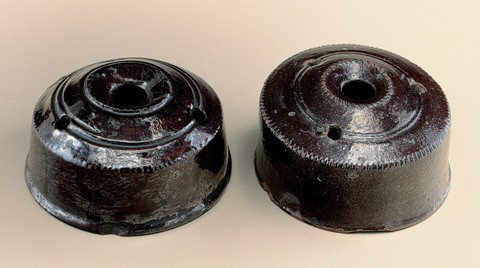
Inkwells, John W. Thompson, Morgantown, West Virginia, ca. 1830– 1854. Earthenware. H. 2" and 2 1/4". (Private collection; photo, Gavin Ashworth.) The inkwell at left is impressed “J.W. THOMPSON / MORGANTOWN, VA.”; the one at right is impressed “Thompson.” Three signed inkwells by Thompson are known. This pair differs slightly in shape but has the same fine coggling at the edge of the shoulders. These examples can be compared with the more carefully finished example by Samuel Butter illustrated in fig. 26. The third example, not shown, is signed by Thompson; it is about 50 percent larger and displays a moderately dark, slightly yellow, shade of green.

Detail of the mark on the inkwell at left illustrated in fig. 23.
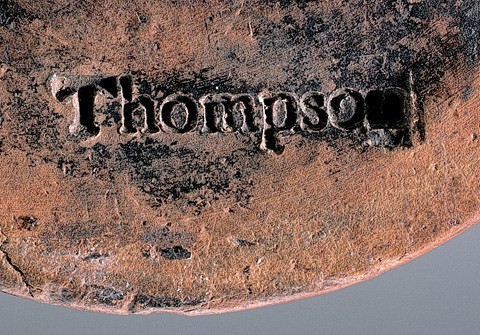
Detail of the mark on the inkwell at right illustrated in fig. 23.

Inkwell, Samuel Butter, Clarksburg, West Virginia, ca. 1820. Earthenware. H. 2 1/2". (Courtesy, Hardy Collection; photo, Gavin Ashworth.) Note that the glaze appears thicker and more lustrous than on the Thompson examples illustrated in fig. 23.

Detail of the mark on the bottom of the inkwell illustrated in fig. 26. Note the lack of the final “s” in Butter’s last name and the absence of “& Co,” which appears in his later marks (see fig. 64).

Jug, Samuel Butter, Clarksburg, West Virginia, ca. 1820– 1850. Earthenware. H. 6 3/8". (Photo, Richard Duez.) Signed on the bottom, this bulbous jug has a high luster lead glaze over a straw- colored slip. Found in southern Harrison County, West Virginia.

Jug, probably Morgantown, West Virginia, ca. 1805–1840. Earthenware. H. 6 3/4". (Private collection; photo, Gavin Ashworth.) The thin straw glaze on this jug reveals much of the red clay body.
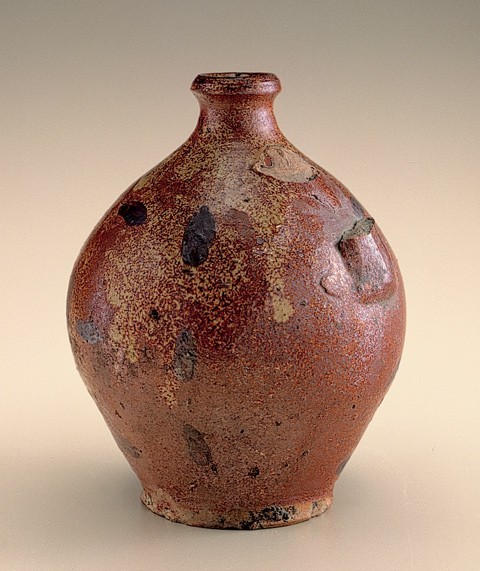
Jug, probably Morgantown, West Virginia, ca. 1805–1840. Earthenware. H. 6 3/4". (Private collection; photo, Gavin Ashworth.) This jug is decorated with alternating spots of manganese in a grid-like pattern.

Jug, probably Morgantown, West Virginia, ca. 1820 –1850. Earthenware. H. 8 5/8". (Private collection; photo, Gavin Ashworth.) The spout rim of this jug resembles that of the flask illustrated in fig. 21.

Jug, Morgantown, West Virginia, ca. 1820–1850. Earthenware. H. 6 1/4". (Private collection; photo, Gavin Ashworth.) Note the brushed manganese slip decoration.
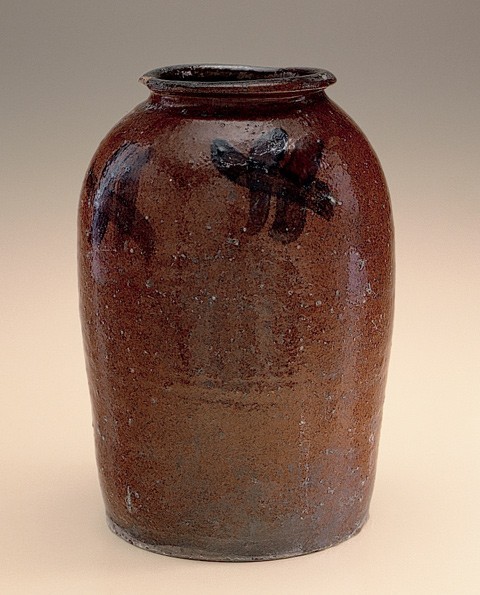
Jar, Morgantown, West Virginia, ca. 1820–1850. Earthenware. H. 11 3/4". (Private collection; photo, Gavin Ashworth.) Brushed manganese slip decoration adorns this early molasses jar. (Molasses was uncrystallized maple sugar.) Several spalls reveal gravel in the body.
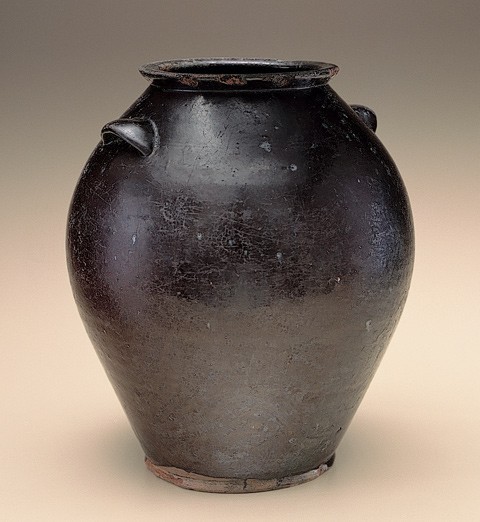
Jar, Morgantown, West Virginia, ca. 1820–1854. H. 11 1/2". (Private collection; photo, Gavin Ashworth.) Two similar examples are illustrated in Walter Hough, “An Early West Virginia Pottery,” pl. 2, fig. 1, where they are referred to as “Molasses Jars.”
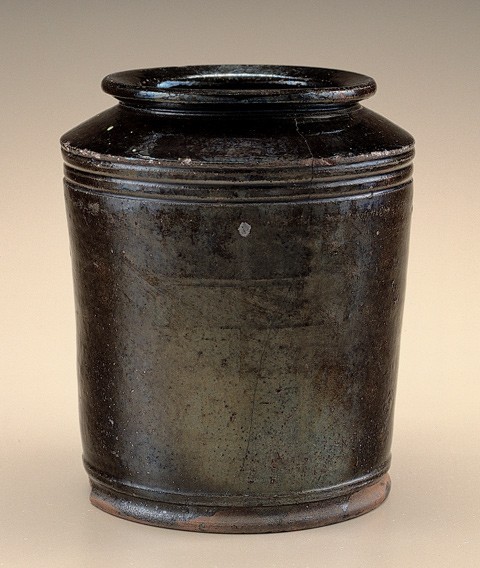
Jar, Morgantown, West Virginia, 1840–1854. Earthenware. H. 7 1/4". (Duez collection; photo, Gavin Ashworth.) Although this jar appears primarily black, in bright daylight highlights of green and yellow are visible throughout the glaze.

Bottle, Morgantown, West Virginia, ca. 1850. Earthenware. H. 5 1/4". (Duez Collection; photo, Gavin Ashworth.) This bottle was perhaps for ink or boot blacking. It was found in a basement next door to the Lot 88 kiln site.

Jar, Morgantown, West Virginia, ca. 1830. Earthenware. H. 1 7/8". (Duez Collection; photo, Gavin Ashworth.) This miniature cylindrical string-tie storage vessel is possibly an ink or ointment jar. It was found in Morgantown.

Jar, Morgantown, West Virginia, ca. 1840–1854. Earthenware. H. 7 1/4". (Private collection; photo, Gavin Ashworth.) This cylindrical string-tie storage jar has an impressed geometric design created by a roulette that is now in the Smithsonian Institution. This same roulette was used in Morgantown’s stoneware period, which began in September 1854. They probably were made near the end of the earthenware period, since roulettes ?ourished in the early stoneware period. Competition from glassmakers—Albert Gallatin’s glass plant at nearby New Geneva, Pennsylvania, began production in 1807—may have forced potters to speed up production to cut costs. Roulette decoration could be completed in one quick rotation of the jar, whereas carefully placed daubs or strokes of slip involved more time and additional material.

Detail of the roulette design on the jar illustrated in fig. 38.

Rouletting tool, Morgantown, West Virginia, ca. 1840–1854. The roulette is a fired clay disk. (Courtesy, National Museum of American History; photo, Gavin Ashworth.)

Jar, Morgantown, West Virginia, ca. 1840–1854. Earthenware. H. 7 1/2". (Duez Collection; photo, Gavin Ashworth.) The geometric roulette design on this cylindrical string-tie storage jar differs from that illustrated in fig. 38. The roulette that made this design is also in the Smithsonian Institution. This roulette was also used on Morgantown stoneware.

Wooden rib, Morgantown, West Virginia, ca. 1840–1854. (Courtesy, National Museum of American History; photo, Gavin Ashworth.) This rib is one of several that are preserved in the Smithsonian Institution. The tool was used to form the contours of the lip and neck of storage jar forms.
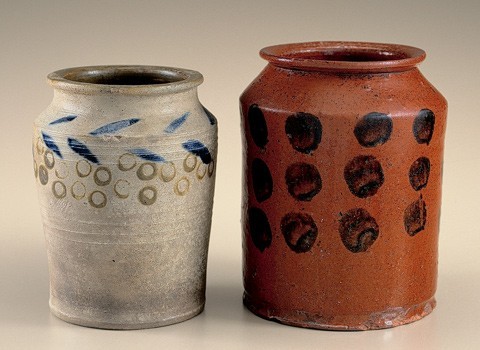
Jars, Morgantown, West Virginia. Left: ca. 1855. Stoneware. H. 5 3/4". Right: ca. 1830–1854. Earthenware. H. 7". (Private collection; photo, Gavin Ashworth.) Note that this earthenware form carried over to the stoneware period; we attribute the innovative decoration to David Greenland Thompson.

Jars, Morgantown, West Virginia, ca. 1820–1854. Earthenware. H. 7 1/2" and 7". (Duez Collection; photo, Gavin Ashworth.) These jars were found together in a house some seventeen miles upstream from Morgantown.

Spice (“Peper”) bottle, David G. Thompson, Morgantown, West Virginia, ca. 1840–1854. Earthenware. H. 5 1/2". (Courtesy, Ceramics and Glass Collection, National Museum of American History.)
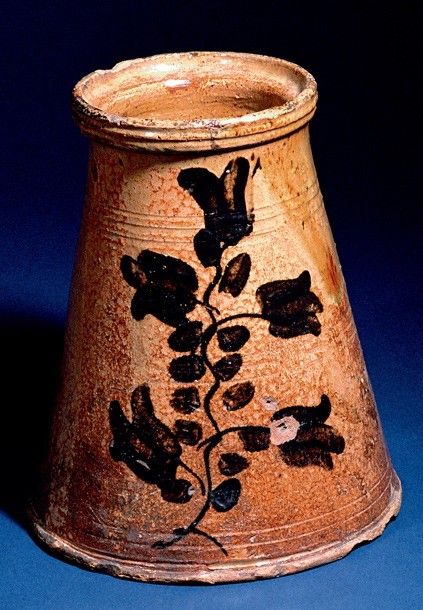
Churn, Thompson pottery, Morgantown, West Virginia, ca. 1840–1854. Earthenware. H. 9 3/4". (Courtesy, Ceramics and Glass Collection, National Museum of American History.)
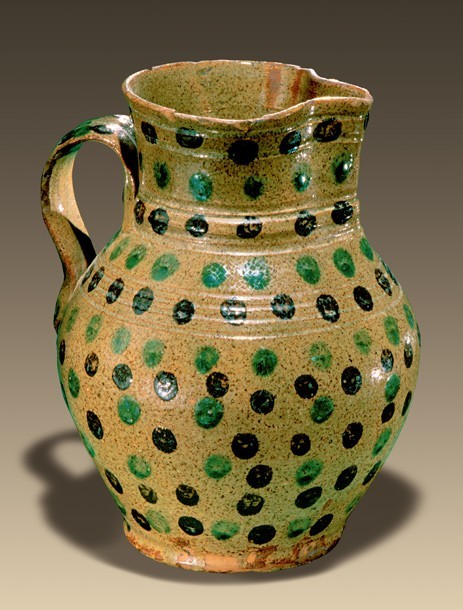
Pitcher, Thompson pottery, Morgantown, West Virginia, ca. 1820– 1840. Earthenware. H. 9 3/4". (Courtesy, Ceramics and Glass Collection, National Museum of American History.)

Pitcher, attributed to the Thompson pottery, Morgantown, West Virginia, ca. 1850. Earthenware. H. 9 3/4". (Courtesy, National Museum of American History; photo, Gavin Ashworth.) The molded spout is the only surviving provincial earthenware example known to us. The molds in the Smithsonian include similar spout designs as well as smaller versions of houses. Molded spouts occur on Staffordshire pottery, and in the 1830s and 1840s Staffordshire potters were moving into East Liverpool, Ohio. A craftsman there might have supplied the Thompsons with molds, although no examples have been seen in that city’s excellent ceramics museum. It is also possible that Thompson employed a Baltimore mold maker, as he maintained contact with this city.
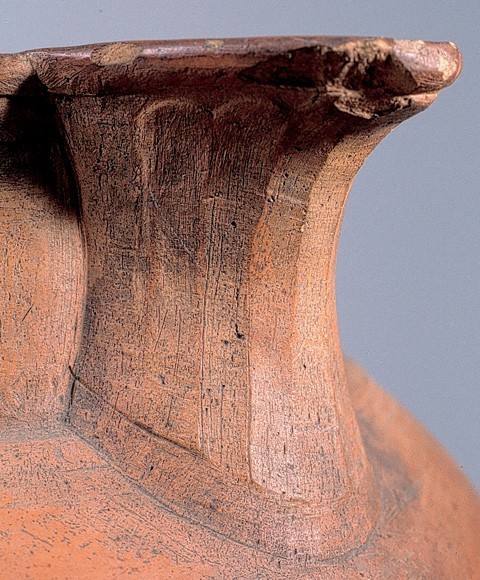
Detail of the spout on the pitcher illustrated in fig. 48.

Spout molds, Thompson pottery, Morgantown, West Virginia. (Courtesy, National Museum of American History; photo, Gavin Ashworth.) This collection of graduated molds suggests that a range of sizes may have been produced at the Thompson pottery.

Extrusion dies. (Courtesy, National Museum of American History; photo, Gavin Ashworth.) An assortment of dies used in conjunction with an extruder to produce various handle shapes and profiles.

Tools, Thompson pottery, Morgantown, West Virginia, nineteenth century. (Courtesy, National Museum of American History; photo, Robert Hunter.) A snapshot of some of the common potting tools, such as ribs, scrapers, and finishing implements. The amazing variety of surviving tools collected by Hough, articularly the roulettes and molds, is to our knowledge unmatched by that from any other American provincial pottery of the early to mid-nineteenth century. They are a wonderful, but dismaying, reminder of what has been lost from other potteries.

Slip cup fragment, attributed to John Sloneker, Morgantown, West Virginia, 1817. Earthenware. (Photo, Gavin Ashworth.)

James J. Thompson, potter. (Courtesy, R. Crommett.)

Francis W. Thompson, potter. (Courtesy, R. Crommett.)

Jar, attributed to William Crichfield, Greene County, Pennsylvania. Stoneware. H. 8". (Duez Collection; photo, Gavin Ashworth.) The body of this jar is covered in a buff-colored slip and decorated with trailed and brushed cobalt. The inscription reads: “Potectiv Tariff.”
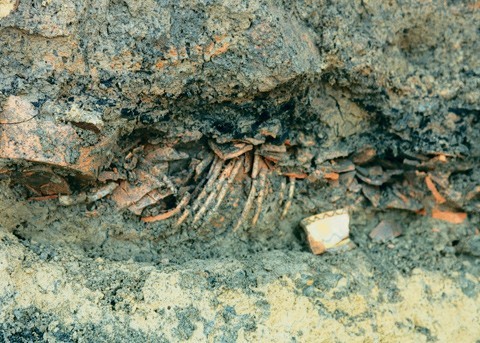
Salvage excavation at the Samuel Butter pottery, Clarksburg, West Virginia. (Photo, Don Horvath.) A hurried and limited opportunity to observe the remains of the Butter pottery came during construction activities on the site. This illustration shows two stacks of slip decorated plates and dishes unearthed during excavation.

Dish fragments, Samuel Butter, Clarksburg, West Virginia, ca. 1820– 1850. Slipware. (Photo, Gavin Ashworth.) This plate shows the use of concentric white slip bands accented with a black slip trailing.

Dish fragments, Samuel Butter, Clarksburg, West Virginia, ca. 1820– 1850. Slipware. (Photo, Gavin Ashworth.)

Dish fragment, Samuel Butter, Clarksburg, West Virginia, ca. 1820–1850. Slipware. (Photo, Gavin Ashworth.) This plate has a coggled rim and a more spontaneous use of black and white slip trailing to form the decoration.

Dish fragment, Samuel Butter, Clarksburg, West Virginia, ca. 1820–1850. Slipware. (Photo, Gavin Ashworth.)

Dish fragment, Samuel Butter, Clarksburg, West Virginia, ca. 1820–1850. Slipware. (Photo, Gavin Ashworth.)

Sherd, Samuel Butter, Clarksburg, West Virginia, ca. 1820–1850. Agateware. (Photo, Gavin Ashworth.) This sherd of an agate red and white clay body, sometime referred to as scroddle ware, is the only known example from the Butter pottery.

Sherd, Samuel Butter, Clarksburg, West Virginia, ca. 1820–1850. Earthenware. (Photo, Gavin Ashworth.) Note the presence of a final “s” in his last name and the addition of “& Co.” Compare this example with the mark illustrated in fig. 27.

Sherds, Samuel Butter, Clarksburg, West Virginia, ca. 1820–1850. Earthenware. (Photo, Richard Duez.)

Tumbler, Pennsylvania or West Virginia, nineteenth century. H. 4". (Private collection; photo, Gavin Ashworth.) From a Morgantown family said to have a potter in its family history. This unglazed example resembles New Geneva tanware though it is less “dry.” Decorated with incised lines and a red slip, the body is very dense and finely finished.
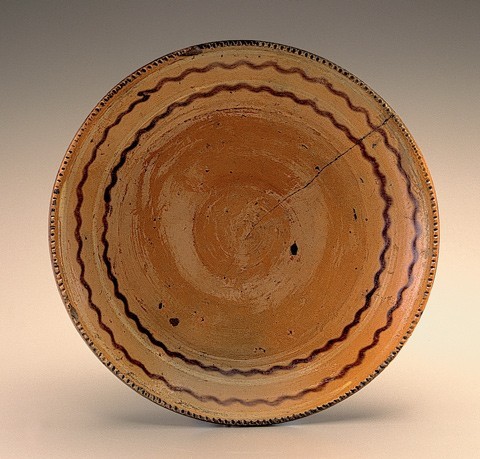
Plate, probably Morgantown, West Virginia, ca. 1800. Earthenware. D. 9". (Private collection; photo, Gavin Ashworth.) This coggled-edge slip-trailed earthenware plate was obtained from an “old” family on Grand Street in Morgantown. Morgantown and Clarksburg potters occasionally coggled plate edges.
